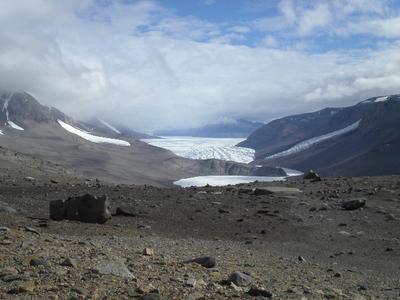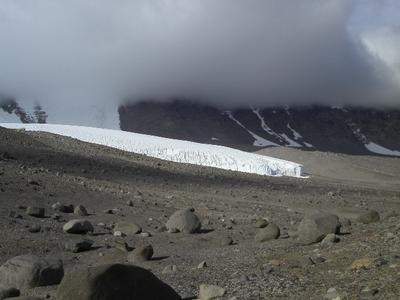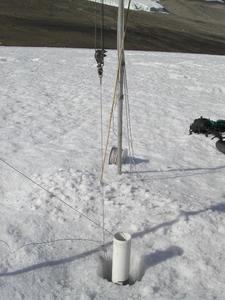12 January, 2003
Lake Bonney - Rock Collecting Near Sollas Glacier
We all slowly dragged ourselves into the cook tent one by one this morning,
eyes at half-mast. Everyone was exhausted from the previous day's work of
breaking down camp and establishing a new camp on the hillside of Lake
Bonney's eastern lobe. During breakfast (It's Sunday so that meant
pancakes.) Chris gave us our assignments for the day. One team would go
onto the ice to begin boring through the ice and the other team would set
off to collect rocks and minerals.
The ice team's goal for the day was to drill through the ice. For this they
used the jiffy auger which is motorized. We had used this the first day at
Lake Fryxell, but the ice there was quite different. There, the jiffy auger
required many people to handle it, and the engine quickly overheated.
However, the ice at Lake Bonney is what they call candle ice and when you
drill it, the pieces come off in long shards. In lakes, ice crystals form
perpendicular to the lake surface. Then, as the sun hits the surface of the
lake, areas between crystals melt out, thereby making drilling easy as
shards of ice crystals break away. However, because Fryxell once contained
a snow cover, light cannot penetrate as well and so the ice remains denser.
The ice team spent the remainder of the day feeding 39 meters (127 feet) of
PVC pipe down through the hole to create a casing. The idea on this lake is
to send a corer, lowered by extension poles, into the casing. A casing
would help prevent bending of the extension poles and oblong rod when coring
at such deep levels. (This lake is nearly twice as deep as Lake Fryxell.)
Connecting 13 pieces of high-pressure water pipe at three meters each is a
long process and took the remainder of the day.
I was assigned to the rock collecting team. We climbed approximately 1200
feet up the valley walls. The view from the top was amazing. We could see
all of Taylor Glacier in the distance and many beautiful formations in the
mountains --- black volcanic cinder cones, huge scoria deposits, ventifacts
(rocks carved by wind) the size of trucks, and tremendous areas of exposed
granite. We walked across several moraines (deposits of sediment that
collect around the edges of a glacier) collecting samples of carbonates and
gypsum. The carbonates (deposits similar to limestone) are formed when
algae photosynthesize and make the lake more alkaline causing the carbonate
to precipitate and fall to the bottom of the lake. So by finding
carbonates, Sarah hopes to provide evidence of past lake levels as part of
her graduate work. We also collected gypsum that will be used to date the
moraines using uranium thorium dating.
One segment of our walk took us across a vast area carpeted with reddish
bits of scoria (volcanic rock). It felt as though we were walking on Mars.
As you turn and look around you there is no sign of life in any direction.
It is a very strange feeling.
I thoroughly enjoyed this walk. This place could turn anyone into a rock
and mineral collector. For my former earth science students who are
following my trip, you would have had a great time here collecting granite,
gneiss, large feldspar crystals, basalt, scoria, sandstones, and more. Many
years ago when I started teaching earth science I knew very little about
rocks and minerals. I'd like to thank my colleague in Rockland, Paul
Kerrigan who taught me the basics of rocks and minerals, but more
importantly got me excited about them. Because he shared his knowledge with
me, I have a greater appreciation for the things I am seeing here and the
samples I am collecting.
It was a long, strenuous hike, and the winds at the higher elevation were
strong. Despite cold hands and face, we collected for a full day before
heading back down to our camp in the valley far below.
I would like to include a joke for the day today. If you think it is
cute... I'll take credit, if not... let me state for the record that it is
compliments of Asst. Superintendent Jim Kerrigan.
Q. What kind of fish do penguins catch at night?
A. Starfish
OK.... Let's try one more!
Q. What do penguins have for lunch?
A. Icebergers

In the distance is Taylor Glacier. In the center of the picture, that snow patch is Lake Bonney. If you look carefully at the rocks in the foreground, you can see that they have been shaped and carved by the wind (ventifacts).

Sollas glacier.=A0 The snout (end) of the glacier is over 70 feet high.=A0 Taylor Valley runs east to west and so this glacier is located on the south side of the valley walls

Hughes Glacier on the south wall of Taylor Valley.

PVC Casing in a hole at Lake Bonney. The corer will be lowered into the casing to help prevent bending of the apparatus.
Contact the TEA in the field at
.
If you cannot connect through your browser, copy the
TEA's e-mail address in the "To:" line of
your favorite e-mail package.
|
